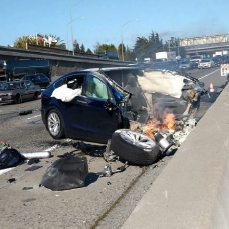Distraction occurs when drivers divert their attention away from the driving task. Crash data and research indicate personal electronic devices, such as cell phones and tablets, are one of the greatest contributors to driver distraction.
Hands-free is not risk free. Using a device hands-free does not reduce driver distraction; in fact, drivers are still distracted by the conversation-this is called “cognitive distraction.”
Many drivers believe they can multitask and still operate a vehicle safely. But multitasking is a myth. Humans can only focus cognitive attention on one task at a time. That’s why the driving task should be a driver’s sole focus.
Distracted driving is widespread, killing thousands and injuring hundreds of thousands in the United States every year. States are making some progress addressing this public health problem, but no state has implemented our recommendation calling for a ban on the use of all personal electronic devices while driving except in case of emergency. Today, 24 states and the District of Columbia prohibit drivers of all ages from using handheld cell phones while driving. Forty-eight states and DC have an all-driver text messaging restriction. However, Missouri and Montana have yet to adopt an all-driver text messaging ban, and drivers in Nebraska and Ohio are only subject to secondary enforcement. Thirty-seven states and DC restrict the use of cell phones by novice drivers.
Lessons Learned: NTSB Investigations
The following crashes best exemplify why this safety improvement is needed.
 Collision Between a Sport Utility Vehicle Operating with Partial Driving Automation and a Crash Attenuator
Collision Between a Sport Utility Vehicle Operating with Partial Driving Automation and a Crash Attenuator
Mountain View, CA | March 2018
 Collapse of the Interstate 5 Skagit River Bridge Following a Strike by an Oversize Combination Vehicle
Collapse of the Interstate 5 Skagit River Bridge Following a Strike by an Oversize Combination Vehicle
Mt. Vernon, WA | May 2013
 Multivehicle Collision Interstate 44 Eastbound
Multivehicle Collision Interstate 44 Eastbound
Gray Summit, MO | August 2010
Stats to Know
424,000
People injured in crashes involving distracted drivers in 2019 (Source: NHTSA)
3,142
People killed in crashes involving distracted drivers in 2020 (Source: NHTSA)
294
Estimated smartphone users in the United States in 2020 (in millions) (Source: Statista 2021)
Our Solutions . . . Take Action Now!
We believe distraction can best be addressed through a combination of education, legislation, and enforcement.
States should:
- Ban all-driver use of personal electronic devices.
- Strictly enforce laws and strengthen roadside monitoring and enforcement programs.
- Operator/Industry/Advocacy groups should:
- Educate the public. Teach drivers, operators, and safety-critical personnel about the dangers of distractions.
- Encourage employers and fleet owners to adopt policies that would prohibit cell phone use while driving or require the use of lockout features when using company vehicles.
Vehicle manufacturers should:
- When designing and incorporating infotainment systems, consider the level of distraction they will create for drivers and restrict access when the vehicle is in motion.
Public (drivers) should:
- Recognize that safe driving requires 100% of a driver’s attention 100% of the time. Distraction is not only about holding a device in your hand or glancing away from the road; it also involves mentally straying from the driving task. Remember, you can’t multitask!
See our specific detailed
recommendations.
Updated December 23, 2022
